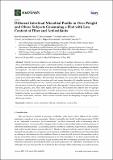Por favor, use este identificador para citar o enlazar a este item:
http://hdl.handle.net/10261/164187COMPARTIR / EXPORTAR:
 SHARE SHARE
 CORE
BASE CORE
BASE
|
|
| Visualizar otros formatos: MARC | Dublin Core | RDF | ORE | MODS | METS | DIDL | DATACITE | |

| Título: | Different Intestinal Microbial Profile in Over-Weight and Obese Subjects Consuming a Diet with Low Content of Fiber and Antioxidants |
Autor: | Fernández-Navarro, Tania CSIC ORCID; Salazar, Nuria CSIC ORCID; Gutiérrez-Díaz, Isabel CSIC ORCID CVN; González de los Reyes-Gavilán, Clara CSIC ORCID ; Gueimonde Fernández, Miguel CSIC ORCID ; González Solares, Sonia | Fecha de publicación: | 27-may-2017 | Editor: | Multidisciplinary Digital Publishing Institute | Citación: | Nutrients 9 (6): 551 (2017) | Resumen: | Obesity has been related to an increased risk of multiple diseases in which oxidative stress and inflammation play a role. Gut microbiota has emerged as a mediator in this interaction, providing new mechanistic insights at the interface between fat metabolism dysregulation and obesity development. Our aim was to analyze the interrelationship among obesity, diet, oxidative stress, inflammation and the intestinal microbiota in 68 healthy adults (29.4% normal-weight). Diet was assessed through a food frequency questionnaire and converted into nutrients and dietary compounds using food composition tables. The intestinal microbiota was assessed by quantitative PCR, fecal short chain fatty acids by gas chromatography and serum biomarkers by standard protocols. Higher levels of malondialdehyde (MDA), C reactive protein (CRP), serum leptin, glucose, fat percentage and the intestinal <i>Lactobacillus</i> group were found in the obese people. Cluster analysis of body mass index, fat mass, glucose, LDL/HDL ratio, leptin, MDA and CRP classified the subjects into two groups. The levels of the intestinal <i>Bacteroides-Prevotella-Porphyromonas</i> group were lower in the cluster and linked to a higher pro-oxidant and pro-inflammatory status, whose individuals also had lower intake of fruits, dried fruits, and fish. These results could be useful for designing strategies targeted to obesity prevention. | Versión del editor: | http://dx.doi.org/10.3390/nu9060551 | URI: | http://hdl.handle.net/10261/164187 | DOI: | 10.3390/nu9060551 | Identificadores: | doi: 10.3390/nu9060551 |
| Aparece en las colecciones: | (IPLA) Artículos |
Ficheros en este ítem:
| Fichero | Descripción | Tamaño | Formato | |
|---|---|---|---|---|
| nutrients-09-00551.pdf | 1,48 MB | Adobe PDF |  Visualizar/Abrir |
CORE Recommender
PubMed Central
Citations
19
checked on 12-abr-2024
SCOPUSTM
Citations
36
checked on 19-abr-2024
WEB OF SCIENCETM
Citations
35
checked on 28-feb-2024
Page view(s)
334
checked on 23-abr-2024
Download(s)
149
checked on 23-abr-2024

